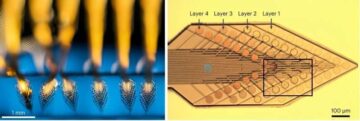From Phys.Org:
 Recording the activity of large populations of single neurons in the brain over long periods of time is crucial to further our understanding of neural circuits, to enable novel medical device-based therapies and, in the future, for brain–computer interfaces requiring high-resolution electrophysiological information. But today there is a tradeoff between how much high-resolution information an implanted device can measure and how long it can maintain recording or stimulation performances. Rigid, silicon implants with many sensors, can collect a lot of information but can’t stay in the body for very long. Flexible, smaller devices are less intrusive and can last longer in the brain but only provide a fraction of the available neural information.
Recording the activity of large populations of single neurons in the brain over long periods of time is crucial to further our understanding of neural circuits, to enable novel medical device-based therapies and, in the future, for brain–computer interfaces requiring high-resolution electrophysiological information. But today there is a tradeoff between how much high-resolution information an implanted device can measure and how long it can maintain recording or stimulation performances. Rigid, silicon implants with many sensors, can collect a lot of information but can’t stay in the body for very long. Flexible, smaller devices are less intrusive and can last longer in the brain but only provide a fraction of the available neural information.
Recently, an interdisciplinary team of researchers from the Harvard John A. Paulson School of Engineering and Applied Sciences (SEAS), in collaboration with The University of Texas at Austin, MIT and Axoft, Inc., developed a soft implantable device with dozens of sensors that can record single-neuron activity in the brain stably for months. The research was published in Nature Nanotechnology.
“We have developed brain–electronics interfaces with single-cell resolution that are more biologically compliant than traditional materials,” said Paul Le Floch, first author of the paper and former graduate student in the lab of Jia Liu, Assistant Professor of Bioengineering at SEAS. “This work has the potential to revolutionize the design of bioelectronics for neural recording and stimulation, and for brain–computer interfaces.”
More here.
